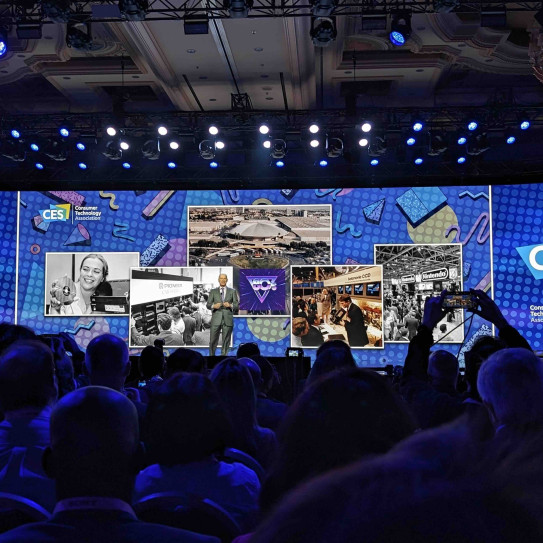
SXSW 2024: the main tech innovations to take away
Each year, South by Southwest – an iconic festival held in Austin, Texas – attracts more than 300,000 participants with a passion for films, music and tech. Now 37 years old, this exceptional event puts the spotlight on top talent in creative and marketing fields. Over the course of eight packed days, festival-goers explored technological advances and societal changes, looking ahead to the tech innovations and trends that will shape the future.
With hundreds of conferences covering a great variety of topics, such as Artificial Intelligence, deeptech, health, robotics, mobility, Web3, retail and climate change, SXSW offers a unique opportunity for our expert consultants and customers to reflect and get inspired. What are the tech trends to take away from this year’s festival?
Tech innovations in the area of IoT
Each second, 127 new devices connect to the Internet. The proliferation of connected objects, fitted with numerous sensors, is generating an astronomical quantity of data to be fed into artificial intelligences. These connected objects are gradually evolving to form interconnected ecosystems, giving rise to Connected Ecosystems of Things (CET).
At the same time, the trend is towards increasingly energy-efficient devices, through the integration of ultra-low-power technologies, sometimes not even requiring batteries. They are also being totally redesigned to ensure greater security. Forecasts predict that the market will be worth as much as 503.07 billion dollars by 2029.

Tech innovations in the area of AI
In-depth corporate restructuring
It is beyond question that no sector or profession is unaffected by artificial intelligence. Experts all agree on one point: the world is already being shaped by AI; and companies that put off investing in it run the risk of falling behind and rapidly becoming obsolete. Some even go so far as to speak of an imminent revolution in companies’ organisational structures,-with the gradual disappearance of experts making way for an economy built on hyper generalists, where individuals will manage AI.
Increasingly powerful AIs
Several phenomena are currently converging:
- Firstly, there is the growth in computing power, illustrated by the race to build larger, more powerful and more energy-efficient GPUs (Graphics Processing Units), as discussed in the recent conference by the global computing leader Nvidia.
- Elsewhere, the emergence of intermediaries – such as the startup Groq, with its LPU (Language Processing Unit) named the ‘GroqChip’ – is remarkably speeding up LLM (Large Language Model) processing, paving the way for faster and more powerful AIs.
- Lastly, there is the proliferation of AIs that are specialised and optimised for specific tasks, with some even able to operate locally on computers or smartphones, as demonstrated by the company AMD with its AIPC (AI-powered PC). The French company Mistral, on the other hand, provides AIs that are small in size, but can outperform some of today’s larger AI models.
From LLMs to LAMs
The growing amount of power granted to AIs was a major topic of discussion during this year’s SXSW. Up until now, they were mostly limited to information searching and processing; however, they are gradually being entrusted with a wider range of tasks. These changes will contribute to the expansion of our connected ecosystems of things (CET) and the transformation of LLMs (Large Language Models) into LAMs (Large Actions Models) to generate concrete actions, such as buying train tickets and making.
AI bias and addiction
Numerous recent examples highlight the importance of understanding and managing inherent bias in artificial intelligences, in order to ensure accurate and fair results. One revealing example was that of a facial recognition AI used for passenger boarding in American airports. While it was designed to optimise efficiency and save time, this technology unfortunately generated recognition errors due to insufficient training. The maker now faces legitimate criticism and the need to rectify its avoidable shortcomings.
Another worrying phenomenon observed is the tendency to unquestioningly accept results produced by AIs. Like a form of addiction, we run the risk of becoming increasingly dependent on these technologies in our everyday lives, to the point of losing the ability to call into question their answers, or even to answer simple questions ourselves. .

Tech innovations in the area of biotech
Synthetic biology
The fusion of synthetic biology with artificial intelligence is opening up vast prospects in the field of health. It can speed up research by testing numerous avenues far more rapidly, and by putting forward previously unimagined hypotheses. This coming together promises significant advances, particularly in the discovery of new molecules, innovative treatments and drugs that are personalised for individuals' DNA
Organoid intelligence
The concept of organoid intelligence is also attracting interest, with the use of microprocessors based on human cells. This idea is highlighting the possible fusion of biotechnology and computing. It also raises questions, however, about a future where we may envisage “growing” our computers like plants, choosing the most intelligent cell donor on the market, and so on.

Tech innovations in the area of augmented reality
The emergence of face computers, such as connected eyewear and headsets, promises to replace smartphones in our everyday lives. Such devices, represented by products like the Apple Vision Pro, herald a major transformation in the way we interact with technology, towards personalised immersive experiences. .

The convergence of artificial intelligence and augmented reality technologies to redefine spatial computing is opening up new prospects for tomorrow’s user interfaces. This change promises to revolutionise our interactions with the digital realm and the real world, raising many questions about future uses in our personal and work lives, as well as consumption habits. Initial studies indicate that the use of spatial computing in work environments increases the capacity to remember information, thereby facilitating learning.
Like any new technology, though, promising prospects go hand in hand with more concerning aspects, with reality sometimes verging on Black Mirror-esque dystopian scenarios. Imagine, for example, a situation where customers are doing their shopping in a supermarket. Some are unable to afford certain products, unless they stop in each aisle to watch ads that give them discounts. The other more affluent customers do their shopping without worrying about prices and being subjected to the ads shown. Such a scenario, where access to technology accentuates divisions, raises ethical and social questions of fairness.

Tech innovations helping to fight loneliness and depression
Dangers linked to hyper-digitalisation, such as loneliness and depression, are of increasing concern, particularly among young people. As a reminder, one out of ten people is in a situation of total isolation, while one in three is in a situation of relational fragility.
Conversely, many solutions are emerging, such as robots and assistants with built-in AI and empathy, which are able to analyse a person’s voice, facial expressions and body language, and act in response. Social assistance robots are already being deployed in hospitals in countries like the United States, Japan and France; and, over the next five to ten years, the purchase of personal robots will become as commonplace as buying a car. In Korea, specialist companies are developing AIs that are able to adopt the identity of a deceased relative, offering a means of support and communication for grieving families.
This year’s SXSW showed us the significant impact of digital technologies on our wellbeing, mental health and social relationships. The trends presented are a cause for both hope and concern, as they raise fundamental questions about ethics, society and humanity. How do we preserve the authenticity and depth of our emotional ties in a hyperconnected world? How do we use digital tools to improve our resilience and creativity, while avoiding dependency and manipulation? How do we ensure respect for individuals’ privacy and dignity in the face of algorithms and robots? These are all challenges that we must tackle collectively to shape a more human and rewarding future.
Are you excited to find out what the future holds in store for us? See you next year in Austin for SXSW 2025!




